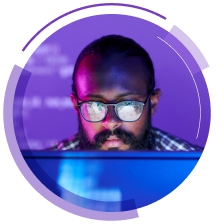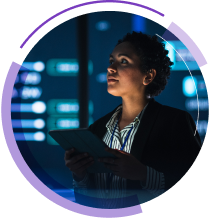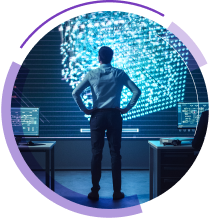Lingaro Data Science and AI Conferences
Explore the contributions of Lingaro's Data Science and AI Practice in leading conferences.
Start fueling your vision today!

.jpg)
Timeline

Beyond Vehicle Routing: Optimizing Salesforce Deployment
In this session, we present a success story where we helped an F&B company standardize and improve its method for deploying salespeople to stores that carry its products. Learn how you too can save considerable costs by preventing over- and under-deployment, while also increasing your deployment coverage to identify growth opportunities with little to no increase in cost.

Databricks Asset Bundles for MLOps: Experience and Analysis
When working on ML projects, managing MLOps processes in a clear and intuitive way presents a variety of challenges. A new and effective tool for addressing these challenges is Databricks Asset Bundles (DAB).
This presentation showcases how DAB can be used to implement ML projects using best practices in MLOps. It reveals in detail how the tool works under the hood and explores how DAB simplifies MLOps from the perspective of a platform team. In addition, it covers best practices for using DAB and highlights the challenges we encountered while using the tool.

RAGOps: LLMOps for RAGs in Practice with Langfuse

Causal ML for Price and Promotions

LLM Talk2Data Assistants: How to Address Real Business Needs With MultiAgent LLM Frameworks

RAG in Practice: Databricks and Kubernetes as Key AI Technologies Across Cloud, On-Premises, and Air-Gapped Environments

Typical Traps of BI Deployments
Lack of understanding between stakeholders and IT is always a major problem during deployments of BI systems. It can possibly even result to an unsatisfactory final product.
This session covers typical pain points based on particular use cases of BI deployments as well as the proper methods of project management. These will help business managers and BI developers understand each other better and communicate to address deployment issues.

Beyond Benchmarks: What to Consider When Evaluating Foundational Models for Commercial Use?

Continual Learning for Multimodal Models
Trained AI models can become obsolete as new data becomes available, while retraining large, multimodal models is costly and energy-inefficient. We propose that Continual Learning is the right weapon to fight off obsolescence.
This session discusses the capabilities of Continual Learning methods for multimodal models — particularly vision-language models. It presents the current state of applying Continual Learning to vision-language models, their limitations and opportunities for improvement, and the results of experiments on selected methods.

Modern Data Pipelines with Dagster
This lecture demonstrates how Dagster can be utilized to quickly produce machine learning pipelines and how it can be integrated with current tools like Databricks. It also shows how reducing time to production can reduce costs, and that modeling both tasks and data assets can reduce technical debt, especially when it comes to AI products.

Data-Driven Content Generation With Multimodal AI For Digital Media

Standard Platform Approach as a Solution to the Challenges in Demand Forecasting
Timely and accurate delivery of goods is a crucial competitive advantage. However, generating accurate demand forecasts and efficiently deploying solutions across markets and customers are difficult for multinational CPG companies. This presentation focuses on Lingaro’s approach to these challenges.
In our lecture, we present a platform approach that offers a common data model, high code reusability, and increased efficiency and scalability to address these challenges.

Keeping LLMs on Track: A Practical Guide to Guardrails - Techniques, Frameworks, and Use Cases
Large language models (LLMs) hold immense potential, but their outputs can be unreliable. This presentation focuses on the challenges of output quality and safety how to improve these through the use of guardrails.
Here's an overview of the presentation:
- Overview and definition of the problems concerning LLMs
- Safety issues in generated content
- Introduction to and definition of guardrails
- Guardrail usage
- Conclusions and real-world deployment recommendations

DiversITy: The Key to Success in Data Science and AI Projects?
Data science and AI projects benefit from teams that are composed of people with diverse sets of skills, experiences, and backgrounds. This presentation in particular features the stories of three female data specialists who contributed to the successful completion of two innovative projects. Their fresh perspectives gave rise to innovative ways of fulfilling project goals.

Operationalizing RAGs: LLMOps in Practice with Azure AI
In the rapidly evolving field of AI, operationalizing large language models (LLMs) presents unique challenges and opportunities. The deployment and management of LLMs in production environments require robust operational strategies. The complexity of maintaining model accuracy, ensuring prompt updates, and monitoring system performance necessitates a specialized approach known as LLMOps.
This presentation delves into the practical aspects of LLMOps, focusing on the integration of Retrieval-Augmented Generation (RAG) within Azure AI’s ecosystem. We explore dedicated LLMOps features using Azure's Prompt Flow, including pipelines for LLMs, evaluation frameworks, and monitoring. We demonstrate how to implement a RAG solution using in the Azure AI Machine Learning Studio as well as with the Prompt Flow Python SDK.

Unlocking the Potential of Multimodal AI To Accelerate Business Development: A Case Study Based on Global Data-Driven Projects
Artificial intelligence (AI) has the potential to broaden its own capabilities by integrating different modalities, creating more engaging and interactive experiences. Multimodal generative AI (GenAI) models are capable of perceiving, understanding, and generating content using multiple modalities such as text, speech, image, video, and sound.
Our experts showcase how their implementation can unlock new business value, enabling innovative applications and improving existing ones. They also discuss the challenges and opportunities that these models present to businesses. The experts also share Lingaro’s unique experience and the use cases that can be applied in real business situations such as content creation and knowledge management.

Multimodal GenAI: A Short Story on How the World Is More Than Just Words
This presentation explains multimodal generative AI (GenAI), which can perceive, understand, and generate content in various formats such as text, image, video, and sound. Our experts demonstrate its impact and new possibilities in creating innovative solutions. We also discuss its implementation challenges, use cases, and opportunities.
Here's an overview of the presentation:
- Introduction to and definition of multimodal GenAI
- Overview of available solutions and GenAI techniques
- Use cases based on projects delivered by Lingaro
- Trends, latest developments, and future trajectory of multimodal GenAI

Beyond Benchmarks: What To Consider When Evaluating Foundational Models for Commercial Use
This presentation provides a comprehensive review of critical considerations for utilizing foundational models within commercial use cases, with a focus on computer vision and natural language processing (NLP). It also outlines a systematic framework comprising essential steps for verification.
The presentation illustrates the process through examples of evaluation protocols, offering practical insights into assessing model performance and applicability in real-world scenarios. The analysis will concern mainly generative models, particularly text-to-image synthesis and large language models (LLMs). Through this detailed exploration, participants will gain a deeper understanding of the strategic and technical prerequisites for utilizing foundational models to drive innovation and efficiency in commercial applications.

From Opacity to Transparency: Explainable AI (XAI) Techniques for Interpreting LLMs
In recent years, large language models (LLMs) have demonstrated their usefulness and impressive capabilities in language processing. However, we still do not fully understand how their inner workings allow them to achieve such great performance.
This talk discusses the importance and motivation of using interpretability methods and gives an overview of selected methods. By exploring their effectiveness in demystifying black box models, the audience will learn about tools that can potentially provide valuable insights into the decision-making processes of LLMs. The presentation will mainly focus on methods that are applicable to models that are first pretrained on a large corpus of unlabeled text data and then fine-tuned on a set of labeled data from a specific downstream domain, such the BERT or RoBERTa model.

Generative AI: A Breakthrough or Overrated?
As generative AI becomes more sophisticated and powerful, it is weaved broadly and deeply into our technologies. Will our future be so drastically different because of it?
Lingaro Senior AI Engineer Konrad Łyda, Lingaro AI Competency Manager Marcin Borucki, and No Fluff Jobs IT Project Manager and Team Lead Maciej Staniewski-Łobacz explore our hopes amidst the hype.

Technology Is Not Evil
Experts from No Fluff Jobs Portal and Lingaro will engage in a round table discussion on GenAI’s hype and reality in the data and AI professional services market. The hour-long discussion will cover common fears and actual job realities in the current and future job market for data scientists and AI and software engineers.

Organized by Data Science Club, Polish Japanese Academy of Information Technology
The Data Science Club of the Polish-Japanese Academy of Information Technology (PJATK) organized an event in Warsaw, “Your Date With Data Science,” to share expert insights on a broad range of topics such as generative networks, deep fake, graph neural networks, machine learning, natural language processing, and large language models.
The event was part of a broader initiative to share knowledge on innovations in the industry to the Club members as well as data science enthusiasts, students, and professionals. The Lingaro Data Science and AI Practice was part of a panel of speakers and discussed the latest trends in data science and AI.

Leveraging Cloud-Based Deep Learning Models for Enhanced Computer Vision Application
Where is the exciting frontier of computer vision heading? What is the impact of infusing it with cloud-based deep learning models and large language models (LLMs)?
Discover how these models are shaping the future of AI, escalating scalability, slashing infrastructure costs, and hitting the bull's eye with precision.

Short-Term Load Forecasting: A Case Study of the Spanish Electricity Market
Ever wondered about the dynamism behind electricity demand forecasting? How different forecasting models are when executed, like naive seasonal, regularized linear regression, gradient boosting, ARIMA (autoregressive integrated moving average) and Facebook Prophet? Dive into this session as we put these to the test, specifically for the Spanish grid.

When BI Meets AI - Opportunities, Possibilities, and Challenges (presentation in Polish)

How To Unlock the Potential of Multimodal Generative AI for the Enterprise: An In-Depth Exploration of Techniques, Frameworks, and Use Cases
In this presentation, we’ll explore:
- The vast potential of multimodal generative AI models capable of handling multiple modalities, such as text, speech, image, and video.
- Challenges and opportunities for enterprises, covering state-of-the-art methods and frameworks like AutoGen, Composable Diffusion (CoDi), and NExT-GPT.
- Valuable insights into real business use cases, including content creation and knowledge management.

Meta-Trends in Ethical and Legal AI and Their Practical Applications
With AI regulations in the forge across the globe, the race is on. Recent developments in generative AI have heightened concerns about the socio-technical implications of AI systems — a crucial consideration for applied AI.
In this presentation, we’ll discuss:
- The business perspective on legal and ethical AI.
- The balance of costs and benefits in responsible AI development and explainable AI.
- Microsoft's Responsible AI vs. impending European Union regulations.
This holistic review coupled with case studies provides insights into the workings and applications of responsible AI in large organizations.

Generative AI and Large Language Models: Where Is The Money?
This presentation dives into the latest advancements in large language models (LLMs) and generative AI, and their impact on commercial practices. Continuing the exploration of generative AI models in business applications that began at DSS ML ’23, this presentation provides an update on recent changes in the field.
Key focus areas include:
- Successful implementation strategies for enterprises.
- Effective business models utilizing LLMs and generative AI.
- Updated industry hype curve and industries likely to be profoundly affected by generative AI and LLMs.

AI Delivery Framework: Navigate Projects With Quality and Purpose
In this engaging talk, we will:
- Discuss challenges faced in establishing AI solution delivery frameworks.
- Explore the complexity of machine learning (ML) software, which goes beyond data management to incorporate business logic.
- The importance of interdisciplinary approaches and dynamic data governance for data science practices.
- Modifying tasks of the CRISP-DM to bridge gaps in ML operationalization using our proposed AI Delivery Framework.
- Showcase the AI Delivery Framework as a tool for AI project management and technical leadership.

Using BERT Attention for Data Augmentation: An Overview of Mixing Augmentation Methods for NLP
As natural language processing (NLP) encounters ever-increasing complexity, applying computer vision-inspired (CV) strategies has also become more recognized. How can the attention mechanisms of BERT be harnessed to expand the horizons of data augmentation in NLP?
Key insights from this presentation include:
- Understanding data augmentation for NLP through mixed training samples.
- Application of CV techniques to NLP, insights into BERT’s role, novel applications in data augmentation, and visual examples of augmented outcomes.
- Empirical evaluations of the proposed techniques' effectiveness.

Code Development Best Practices for Data Science Projects
How can embracing structured coding standards foster an environment of innovation without chaos, and set the stage for data science initiatives to really excel?
In this presentation, Konrad will share:
- Structured coding standards and best practices in data science that reinforce innovation and efficiency.
- Overlooked aspects of the software creation process and practical solutions that address issues such as code inconsistency and poor readability.
- How strategies like linting, rigorous testing, and continuous integration foster team cohesion.
- Success stories highlighting the transformational impact of standardized coding practices on team productivity.

Personal Data Protection Challenges in AI
The use of AI has introduced legal and ethical risks, particularly in protecting personal data. The International Association of Privacy Professionals (IAPP) organized the In-Person Poland KnowledgeNet event to discuss practical challenges in safeguarding personal data when implementing AI-based solutions in enterprises.
The Lingaro Data Science and AI Practice was part of a panel of leaders and discussed the latest trends in data science and AI as well as challenges in data privacy from AI and generative AI (GenAI) models.

How To Use BERT (Bidirectional Encoder Representations from Transformers) Attention for Data Augmentation: An Overview of Mixing Augmentation Methods for NLP
The poster provides a comprehensive analysis of different augmentation methods for natural language processing (NLP). It covers various topics:
- Augmentation for NLP
- Mixing for Computer Vision (CV) and NLP
- Use of BERT attention
- Mixing in BERT and Attention Mix, primed with an empirical evaluation on the SST (Stanford Sentiment Treebank) dataset.

My Model Is in Production: What's Next?
This presentation focuses on managing machine learning models in production and assessing new models after training. Key concepts include data drift, concept drift, and lack of generalization, which are demonstrated through a practical project use case.
This use case showcases the integration of Databricks with MLflow, introducing MLflow’s features such as model registry, models versioning, experiments, and deployments.

Image Generative Models for Business Applications: Hype or Reality?
Lingaro's NLP and generative AI experts, delve into the practical application of image generative models in business.
In this engaging talk, they’ll unpack:
- Two business applications of generative models: concept generation for ads and PowerPoint slide generation based on varied format inputs.
- Explanation on what made these innovative projects successful.

Why Modern Data Augmentation Is Unintuitive: An Overview of Mixing Augmentation Methods
Lingaro expert delivers a detailed technical presentation on modern data augmentation techniques, shedding light on:
- Notation, methods covered, and the universal mixing equation.
- Canonical method: Mixup.
- Canonical method: CutMix.
- Empirical evaluation and method similarities.
- Application to other tasks and modalities.

Why Modern Data Augmentation Is Unintuitive: An Overview of Mixing Augmentation Methods
Lingaro expert delivers a detailed technical presentation on modern data augmentation techniques, shedding light on:
- Notation, methods covered, and the universal mixing equation.
- Canonical method: Mixup.
- Canonical method: CutMix.
- Empirical evaluation and method similarities. Application to other tasks and modalities.

“How Many Models?”: Building a Foundation For Many-Model ML in Production
Take a closer look at a real-life case study on developing an efficient framework to put many-model ML solutions into action, utilizing the best practices in MLOps.

Building a Foundation for Many-Models ML in Production: An Implementation Using Azure Machine Learning
Join our expert to get valuable insights on how to leverage MLOps and effectively overcome these hurdles. Experience the journey of designing and building a pioneering framework that fuses MLOps best practices with Microsoft's Azure Machine Learning.
This session will help you understand how a versatile, user-friendly, and production-ready base for many-models machine learning can simplify the complex web of machine learning production.

From EEG Signals and Study of Particles to Sales Forecasting: Why You Need To Know Spectral Methods and Their Applications

AI, You Are 57 Years Old, But Are You Mature?
Is AI really maturing at 57? How can this question be addressed from both a global standpoint and an organizational perspective?
This thought-provoking discussion exposes the gap between AI's scientific achievements and practical application.

Automatic Image Generation for the Application of Generation of Advertisements Adopted to Defined Customer Segments
Journey alongside our Lingaro expert as he unveils the newest approaches in automated image generation, highlighting influential breakthroughs and discussing the implications on security and democratization.

Automatic Image Generation for the Application of Generation of Advertisements Adopted to Defined Customer Segments
This session presents an overview of:
- Automatic image generation for a defined group of clients.
The Fluence project, automatic image generation, innovative framework, and generation examples.
- Fine-tuning of generative model, in embedding space, and with unfrozen weights.

Why Modern Data Augmentation Is Unintuitive: An Overview of Mixing Augmentation Methods
Lingaro expert delivers a detailed technical presentation on modern data augmentation techniques, shedding light on:
- Notation, methods covered, and the universal mixing equation.
- Canonical method: Mixup.
- Canonical method: CutMix.
- Empirical evaluation and method similarities.
- Application to other tasks and modalities.

Social Benefits of Using ML and AI: How ML Could Help People With Disabilities?
This session provides an overview of:
- Practical examples of the voice assistance.
- Experiment on open-source library Merlin.
- Experiment on FastSpeech 2 implementation.
- Experiment on Tacotron 2 implementation.
- MUSHRA (Multiple Stimuli with Hidden Reference and Anchor) and comparing the results of the experiments.

AI Engineering: A New Direction in Development in Big Data, Cloud, and Data Science
AI engineering is a new development trend for software developers, cloud engineers, big data scientists, and data scientists.
Marek Psiuk, CTO of No Fluff Jobs, Błażej Chodarcewicz, director of Lingaro’s Data Science & AI Center of Excellence, and Tomasz Rostkowski, Lingaro AI engineering leader, discuss this and the AI engineer position it creates.

Meet Our Experts

Grzegorz Tkaczyk
Chief Technology Officer

Błażej Chodarcewicz
DS and AI Competency Senior Director

Milena Kurpiewska
Head of Data Science & AI Competency Center
Earlier in her career, Milena served at Facebook and Zalando in both companies’ headquarters. She holds an MA in Quantitative Methods in Economics and Information Systems from the Warsaw School of Economics.

Krystian Jabłoński
Head of GenAI Practice
Krystian has spent over seven years honing his skills in the data and analytics field, with a focus on creating and developing generative AI services. He has demonstrated leadership in managing product and product teams, as well as AI R&D activities, and is appreciated for his ability to translate business challenges into practical AI solutions.

Tomasz Rostkowski
Head of AI Consulting and Advisory
With over 20 years of IT experience, primarily as a Data and Analytics Solutions Architect, Tomasz has spent the last seven years in leadership roles. His extensive experience includes building technical delivery teams, defining service portfolios, and delivering high-quality innovative projects. He also offers strategic technical initiatives, technology management, and technical organization setup advice.

Karolina Głowacka
Senior Data Scientist,
DS & AI Competency Center

Norbert Fijałek
AI Engineering Associate Manager,
DS & AI Competency Center
Norbert has a passion for AI and MLOps. With more than a decade of experience in implementing new technologies, he has developed innovative products and guided teams in delivering successful AI solutions across multiple industries. He enjoys sharing his knowledge, frequently speaking at various conferences on AI and related topics. Norbert is a lifelong learner, always eager to apply the latest technology trends to real-world problems.

Magdalena Kurlanc
Senior Consultant,
BI Tech Lead
With more than 11 years of experience in business intelligence, Magdalena is a Senior Consultant and a recognized Tableau expert. She has organized the past three editions of the Lingaro Data Visualization Challenge and is driven by data analytics, UX, AI, and more recently, SynBio.

Grzegorz Dubicki
AI DevOps Manager and Cloud DevOps Architect
Grzegorz is an AI DevOps Manager and Cloud DevOps Architect, specializing in advanced cloud architectures, Kubernetes, DevOps, CI/CD, and data processing using Databricks and Spark platforms. Passionate about Generative AI, process automation, and a trendsetter in adopting cutting-edge technologies. He is dedicated to designing scalable and efficient solutions that enhance performance, reduce costs, and ensure the highest standards of data security and transparency in AI systems. Grzegorz has extensive experience implementing AI agents and orchestrating AI-powered workflows across both cloud and on-premises environments. He focuses on robust, enterprise-ready infrastructure that enables organizations to unlock the full potential of artificial intelligence.

Agnieszka Rzendkowska-Łapacz
Senior Data Scientist

Marcin Borucki
AI Manager, DS & AI Competency Center
As an AI manager in Data Science & AI Competence Center at Lingaro, Marcin Borucki leads a team of 20 AI specialists, delivering AI-powered solutions for Fortune 500 companies. With a 13-year experience stretching across diverse industries such as professional services, aviation, and banking, Marcin has evolved from a data scientist role to a management path. Additionally, he has made his mark as a seasoned trainer, introducing data science and data analytics to a diverse audience.

Dominik Lewy
Principal Data Scientist,
DS & AI Competency Center
Dominik brings over nine years of hands-on experience in machine learning, deep learning, data exploration, and business analysis, primarily in the FMCG industry. He's a technical leader who develops project roadmaps and sets goals. At Warsaw University of Technology, Dominik is a Ph.D. candidate studying neural networks for image processing and connects the commercial and academic worlds. His primary research interest lies in digital image processing, aiming to facilitate the adoption of deep learning algorithms in business contexts where training data is limited or non-existent.

Taylor van Valkenburg
Data Science Expert/Senior Consultant,
DS & AI Practice Team
Taylor is a seasoned data scientist with a keen interest in the intersection between emerging technologies and public policy. Leveraging best practices in ML engineering and MLOps, Taylor adeptly uses a variety of machine learning and AI technologies to develop effective solutions.
.png)
Adrian Cypcar
AI Associate Manager,
DS & AI Competency Center

Konrad Łyda
Al and ML Senior Engineer,
DS & Al Competency Center
An AI and machine learning expert based in Eastern Poland, Konrad mainly uses Python to create machine learning solutions and thoughtfully implement them. Through clever automation, be it small scale on his computer or large scale through end-to-end machine learning pipelines, Konrad helps data scientists focus on their learning goals.

Wiktor Hawrylik
AI and ML Engineer, Principal Consultant, DS & AI Competency Center
Wiktor specializes in machine learning architectures and cloud optimizations. With years of experience in forecasting, computer vision, and natural language processing, he guides teams towards successful machine learning solution implementations. Being a mathematician, computer scientist, and economist, Wiktor encourages a visionary perspective, aiming to chart the optimal path for AI transformation.

Karol Piniarski
ML/AI Engineer/Lead Consultant,
DS & AI Competency Center

Albert Hupa
AI Advisor, Senior Consultant

Ernest Kuśmierz
Azure Senior DevOps Engineer

Artur Kolishenko
AI Advisor and Engineer
With a background as a startup founder, Artur brings an innovation-driven mindset, blending technical expertise with a deep understanding of business needs. His passion lies in leveraging AI to drive real-world impact, crafting practical, scalable solutions that solve complex challenges and unlock business value.

Łukasz Frydrych
Data Scientist, DS & AI Practice
Łukasz Frydrych is a data scientist with several years of hands-on experience in the application of advanced analytics in various industries like consulting, retail, e-commerce, insurance, banking, and finance. He is an experienced analytics translator who is passionate about driving positive business outcomes by tailoring AI solutions to business needs.

Łukasz Kościński
Senior Business Intelligence Consultant
Since before BI I was deploying ERP systems I always tried to merge approach of developer and analyst – recognize real customer need and only after it was fully understood, provide the proper solution.
Apart from IT I am a public speaker, working with people willing to speak in public and helping them to deliver speeches in an engaging manner.

Tomasz Czochański
ML/AI Engineer


